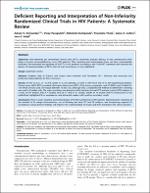Deficient reporting and interpretation of non-inferiority randomized clinical trials in HIV patients: a systematic review.
Related Resource(s)
https://journals.plos.org/plosone/article?id=10.1371/journal.pone.0063272Date
2013-05Author(s)
Hernandez, Adrian V.
Vinay, Pasupuleti
Deshpande, Abhishek
Thota, Priyaleela
Collins, Jaime A.
Vidal, Jose E.
Metadata
Show full item recordAbstract
Los exámenes clínicos randomizados de no inferioridad generalmente evalúan la eficacia de nuevas drogas antirretrovirales en pacientes con el virus de inmunodeficiencia humana. Sus informes e interpretación no han sido evaluados sistemáticamente. En el presente estudio se evalúa los informes de exámenes clínicos randomizados de no inferioridad de pacientes con el virus de inmunodeficiencia humana de acuerdo con el CONSORT (Consolidated Standards of Reporting Trials) y el grado de mala interpretación de los exámenes clínicos randomizados cuando la no inferioridad fue poco concluyente o no establecida. Se realizó una revisión sistemática de PubMed, Science y Scopus hasta diciembre 2011. Se encontró información e interpretación deficiente de los exámenes clínicos randomizados de no inferioridad realizados a pacientes con el virus de inmunodeficiencia humana. Objectives: Non-inferiority (NI) randomized clinical trials (RCTs) commonly evaluate efficacy of new antiretroviral (ARV)
drugs in human immunodeficiency virus (HIV) patients. Their reporting and interpretation have not been systematically
evaluated. We evaluated the reporting of NI RCTs in HIV patients according to the CONSORT statement and assessed the
degree of misinterpretation of RCTs when NI was inconclusive or not established.
Design: Systematic review.
Methods: PubMed, Web of Science, and Scopus were reviewed until December 2011. Selection and extraction was
performed independently by three reviewers.
Results: Of the 42 RCTs (n = 21,919; range 41–3,316) selected, 23 were in ARV-naı¨ve and 19 in ARV-experienced patients.
Twenty-seven (64%) RCTs provided information about prior RCTs of the active comparator, and 37 (88%) used 2-sided CIs.
Two thirds of trials used a NI margin between 10 and 12%, although only 12 explained the method to determine it. Blinding
was used in 9 studies only. The main conclusion was based on both intention-to-treat (ITT) and per protocol (PP) analyses in
5 trials, on PP analysis only in 4 studies, and on ITT only in 31 studies. Eleven of 16 studies with NI inconclusive or not
established highlighted NI or equivalence, and distracted readers with positive secondary results.
Conclusions: There is poor reporting and interpretation of NI RCTs performed in HIV patients. Maximizing the reporting of
the method of NI margin determination, use of blinding and both ITT and PP analyses, and interpreting negative NI
according to actual primary findings will improve the understanding of results and their translation into clinical practice.
Notes
El Consejo Editorial es un equipo de expertos en el campo de la revista.
Collections
- Artículos científicos [890]






